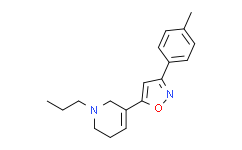| 中文名称: | PD 144418 | ||||
|---|---|---|---|---|---|
| 英文名称: | PD 144418 | ||||
| 别名: | 1,2,3,6-四氢-5-[3-(4-甲基苯基)-5-异恶唑基]-1-丙基吡啶 1,2,3,6-Tetrahydro-5-[3-(4-methylphenyl)-5-isoxazolyl]-1-propylpyridine | ||||
| CAS No: | 154130-99-1 | 分子式: | C18H22N2O | 分子量: | 372.41 |
| CAS No: | 154130-99-1 | ||||
| 分子式: | C18H22N2O | ||||
| 分子量: | 372.41 | ||||
基本信息
|
产品编号: |
P11727 |
||||
|
产品名称: |
PD 144418 |
||||
|
CAS: |
154130-99-1 |
储存条件 |
粉末 |
-20℃ |
四年 |
|
分子式: |
溶于液体 |
-80℃ |
二年 |
||
|
分子量: |
372.41 |
|
|
||
|
化学名: |
1,2,3,6-Tetrahydro-5-[3-(4-methylphenyl)-5-isoxazolyl]-1-propylpyridine |
||||
|
Solubility (25°C): |
|||||
|
体外:
|
DMSO |
|
|||
|
Ethanol |
|
||||
|
Water |
|
||||
|
体内(现配现用): |
|
||||
|
<1mg/ml表示微溶或不溶。 |
|||||
|
普西唐提供的所有化合物浓度为内部测试所得,实际溶液度可能与公布值有所偏差,属于正常的批间细微差异现象。 |
|||||
|
请根据产品在不同溶剂中的溶解度选择合适的溶剂配制储备液;⼀旦配成溶液,请分装保存,避免反复冻融造成的产品失效。 |
|||||
生物活性
|
产品描述 |
一种高亲和力,强效和选择性的 sigma 1 受体 (σ1 receptor) 配体 (对 σ1 和 σ2 的 Ki 值分别为 0.08nM 和 1377nM),对其他受体,离子通道和酶没有任何显着的亲和力。PD 144418 oxalate 具有潜在的抗精神病活性。 |
|
|
靶点 |
Ki:0.08nM (σ1 receptor) and 1377nM (σ2 receptor) |
|
|
体外研究 |
In vitro,PD 144418 reverses the N-methyl-D-aspartate (NMDA)-induced increase in cyclic GMP (cGMP) in rat cerebellar slices without affecting the basal levels,suggesting that σ1 sites may be important in the regulation of glutamine-induced actions.PD 144418 potentiates the decrease in 5-hydroxytryptophan caused by Haloperidol in the mesolimbic region,but by itself has no effect in 5-HT and dopamine (DA) synthesis. |
|
|
体内研究 |
PD 144418 (10mg/kg;intraperitoneal injection;male CD-1 mice) treatment antagonizes Mescaline-induced scratching at doses that did not alter spontaneous motor activity,with PD 144418 showing ED50 values of 7.0mg/kg i.p. |
|
|
Animal Model: |
Male CD-1 mice induced with Mescaline |
|
|
Dosage: |
10mg/kg |
|
|
Administration: |
Intraperitoneal injection |
|
|
Result: |
Antagonized mescaline-induced scratching at doses that did not alter spontaneous motor activity. |
|
本计算器可帮助您计算出特定溶液中溶质的质量、溶液浓度和体积之间的关系,公式为:
质量 (g) = 浓度 (mol/L) x 体积 (L) x 分子量 (g/mol)
摩尔浓度计算公式
用本工具协助配置特定浓度的溶液,使用的计算公式为:
开始浓度 x 开始体积 = 最终浓度 x 最终体积
稀释公式
稀释公式一般简略地表示为:C1V1 = C2V2 ( 输入 输出 )








